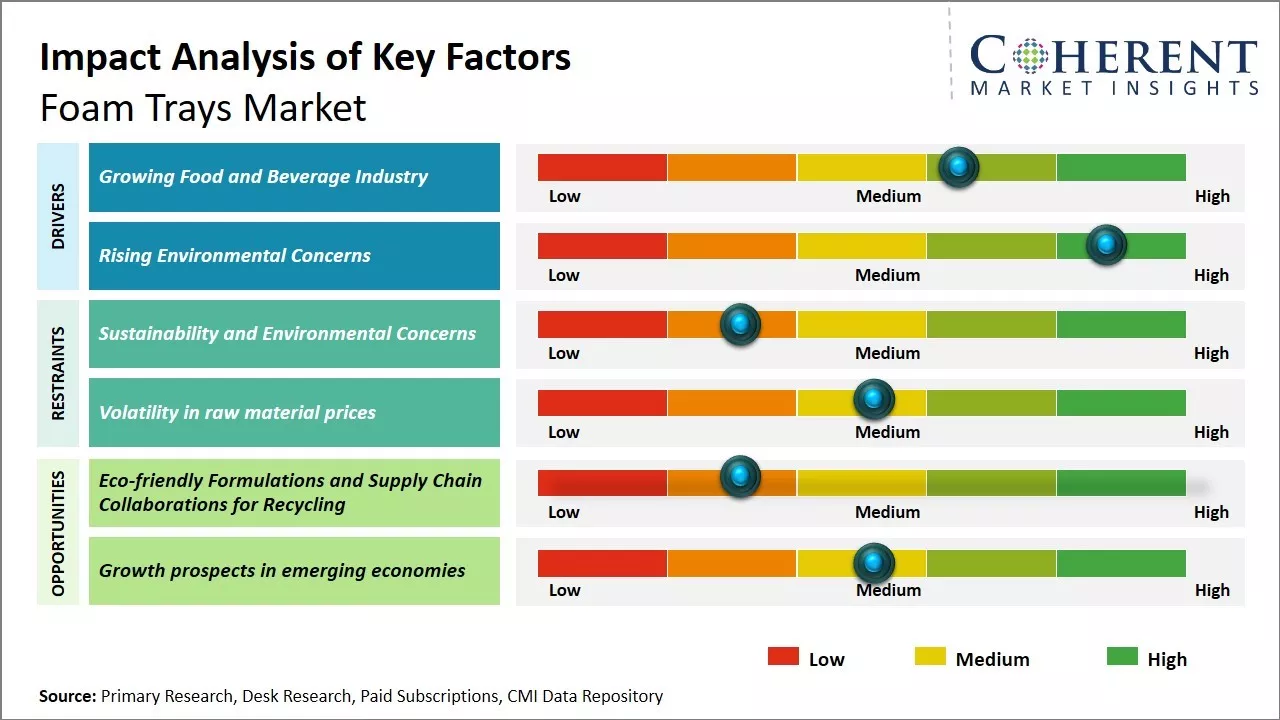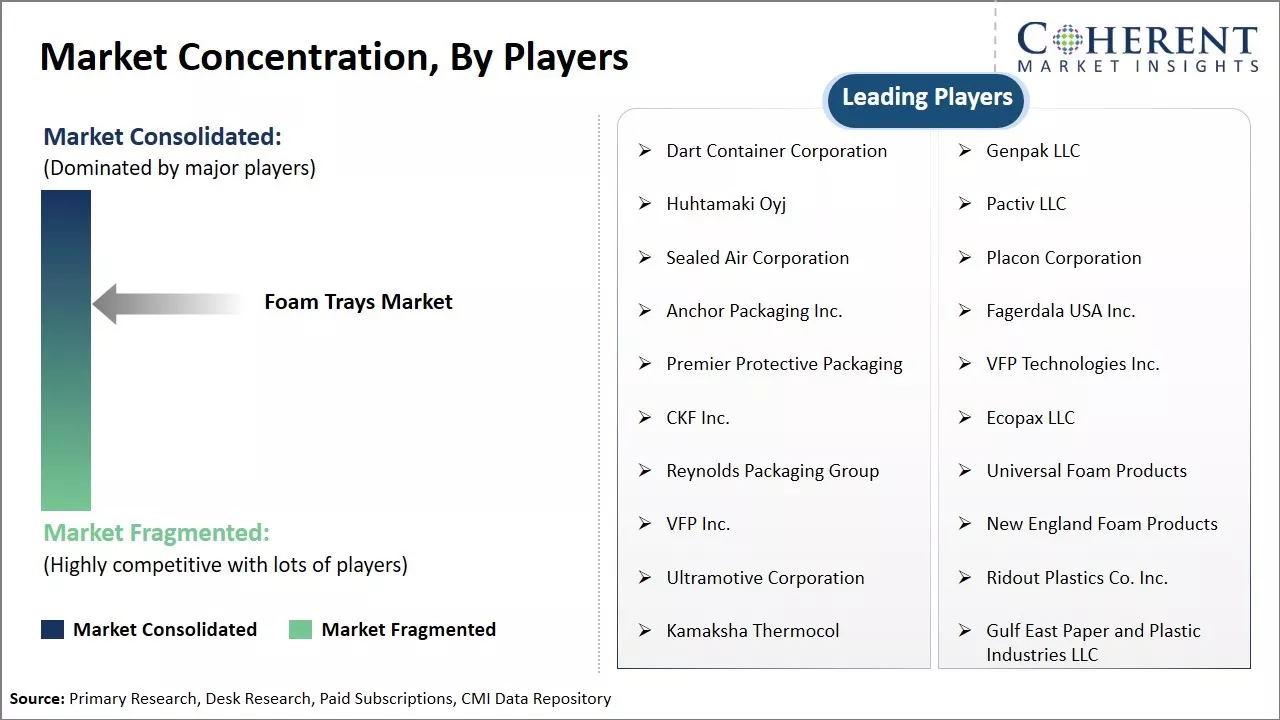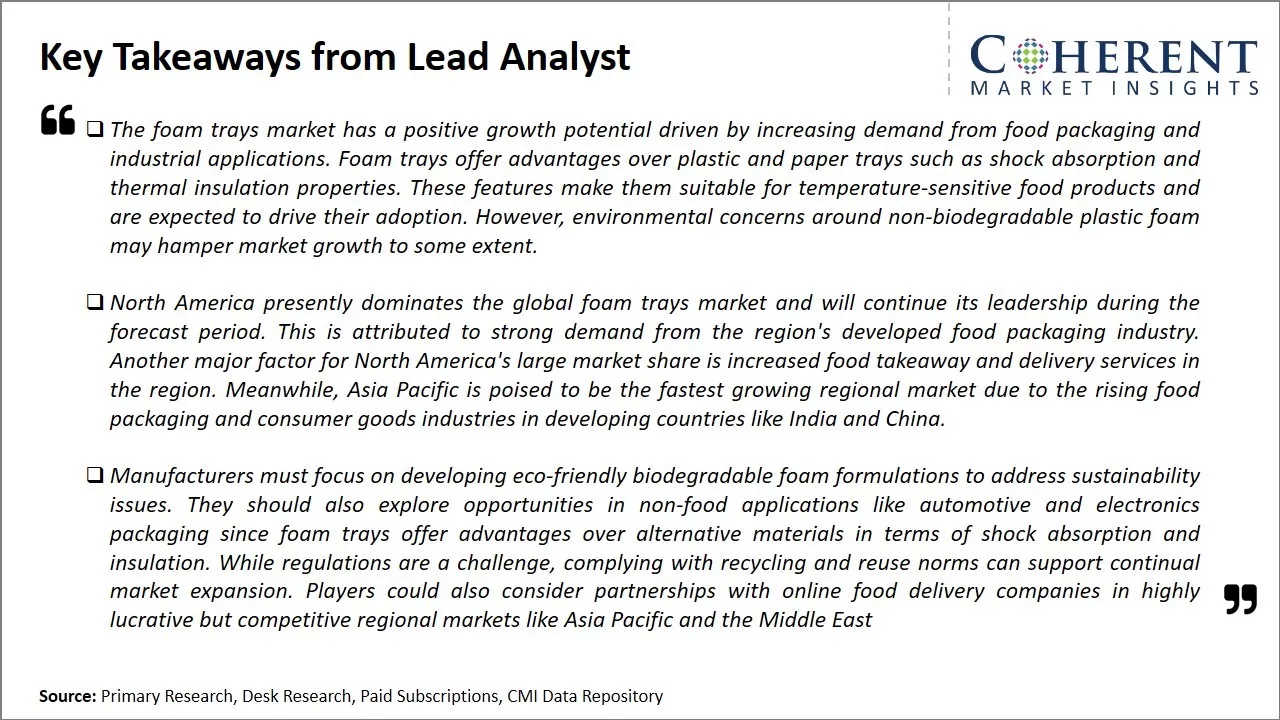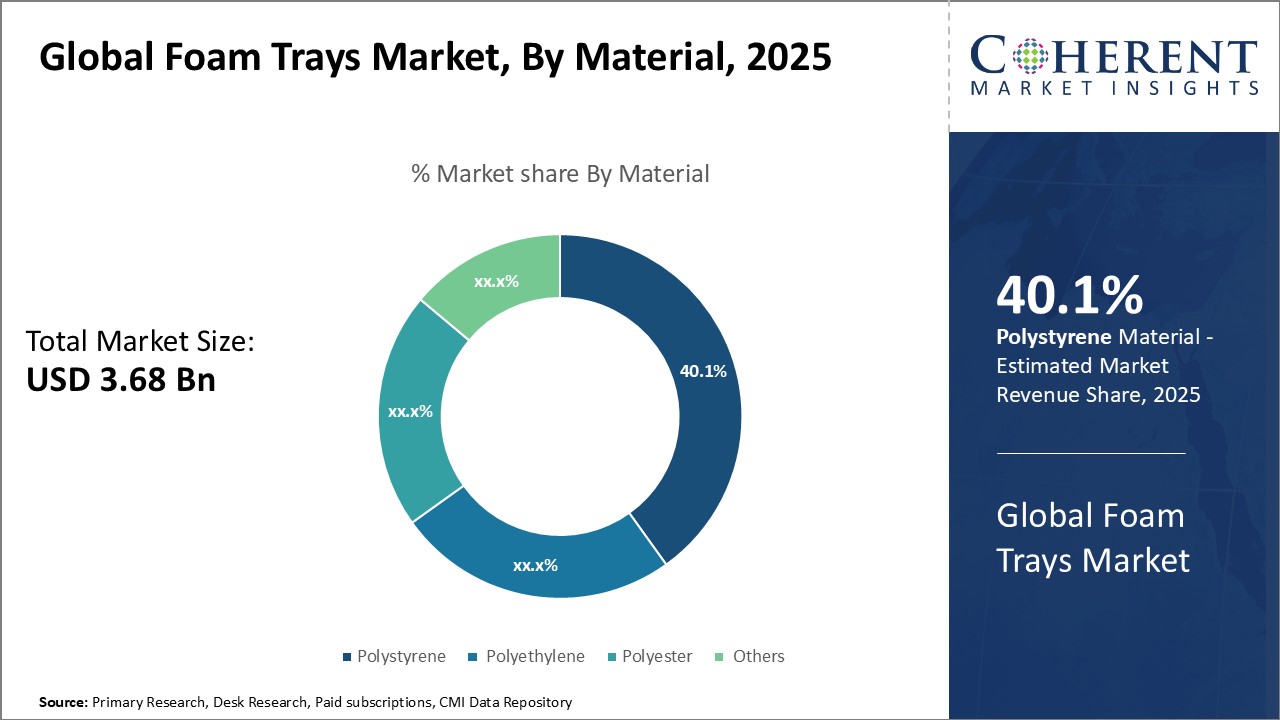Global Foam Trays Market Size and Trends
The foam trays market is estimated to be valued at USD 3.68 Bn in 2025 and is expected to reach USD 4.75 Bn by 2032, growing at a compound annual growth rate (CAGR) of 3.7% from 2025 to 2032.

Discover market dynamics shaping the industry: Download Free Sample
Foam trays are widely used across various end-use industries like food and beverages, pharmaceutical, and personal care and cosmetics industries. The foam trays market is expected to witness positive growth over the forecast period. Rising demand for packaged and ready-to-eat food products is driving the need for effective packaging solutions. Foam trays have emerged as a sustainable and eco-friendly alternative to plastic and polystyrene trays. Furthermore, the ability of foam trays to maintain freshness and minimize product wastage are increasing its adoption across industries.
Growing Food and Beverage Industry
The food and beverage industry has been witnessing significant growth over the past few years with evolving consumer preferences and growing disposable income levels. People are increasingly opting for convenient packaging solutions for food products that allow ease of cooking, reheating, storing and transportation. Foam trays have emerged as one of the most popular packaging formats used in the foodservice industry owing to their lightweight and durable properties. They help protect foods from external elements and potential damage during transportation. Moreover, plastic foam offers excellent insulation which helps maintain the quality and temperature of foods. With the expansion of the QSR sector and demand for ready-to-eat meals rising, foam trays are being extensively used for packaging cooked and semi-cooked food items. The growing consumption of packaged snacks and dry foods has also created a considerable demand from the snacks segment. Food processing companies are actively incorporating foam trays in their packaging mixes to tap growing demand from consumers leading to market growth, therefore, the growing food industry is expected to drive the market growth. For instance, according to data published by Invest India in 2022, by 2025 the Indian food processing market is estimated to reach US$ 535 Bn, growing at a compound annual growth rate of 15.2%.
Market Concentration and Competitive Landscape

Get actionable strategies to beat competition: Download Free Sample
Rising Environmental ConcernsStringent regulations regarding food safety is one of the primary factors driving the growth of the food grade alcohol market. Governments across the world are implementing stricter guidelines to ensure the quality and safety of food products. Alcohol that does not meet the prescribed standards for food consumption cannot be used in the food industry. This has compelled food companies to rely solely on food grade alcohol that adheres to the regulatory norms. The food grade alcohol manufacturing industry has responded proactively to these regulations. Producers are investing heavily in R&D to come up with innovative purity testing technologies and upgrading production facilities. Advanced distillation and filtration methods allow manufacturers to remove impurities and contaminants from alcohol. They can certify that their products meet all criteria specified by regulatory bodies. This gives confidence to food businesses that opt for these alcohols. It has also increased transparency in a supply chain. The trend of stringent norms is likely to continue in the coming years. According to a study by WHO, over 200,000 people require hospitalization every year globally due to contaminated food. Governments are under pressure to strengthen laws to curb foodborne illnesses. The food industry needs to comply with evolving standards. This dependable demand for certified pure alcohol from the food industry will spur growth opportunities for food grade alcohol producers. Food businesses seeking legitimacy are progressive adopters of food grade alcohols. Natural health product makers and packaged food companies requiring alcoholic extracts or extracts will predominantly contribute to revenues. The market holds significant potential with ongoing regulations and responsible manufacturing practices gaining prevalence. Food safety remains a major priority so demand for compliant alcohols is projected to rise substantially over the next decade.

To learn more about this report, Download Free Sample
Market Challenges: Sustainability and Environmental ConcernsOne of the biggest challenges facing the foam trays market is sustainability and environmental concerns. As awareness increases around single-use plastics and their impact on the planet, foam products are coming under greater scrutiny. Stricter regulations around recycling and pollution may pose compliance issues. Additionally, alternatives like biodegradable materials are gaining popularity and capturing market share from foam. Rising raw material costs also present a challenge as petroleum-based prices fluctuate. Labor shortages and supply chain disruptions from the pandemic continue affecting production capabilities.
Market Opportunities: Eco-friendly Formulations and Supply Chain Collaborations for Recycling
The foam trays market remains huge as foam continues to be popular for foodservice and packaging applications requiring cushioning and insulation. Opportunities exist in developing more eco-friendly and recyclable formulations that can alleviate sustainability concerns. Partnerships along the supply chain to improve recycling would also boost growth prospects.

Discover high revenue pocket segments and roadmap to it: Download Free Sample
Insights, By Material: In terms of material, polystyrene contributes the highest share of the market owing to its cost-effectiveness and insulation propertiesPolystyrene accounts for 40.1% share in the foam trays market based on material. It has gained its popularity owing to properties like lightweight, durability, and cost effectiveness. Polystyrene provides effective insulation at low cost compared to other materials. It can maintain the temperature of hot or cold food for longer durations, preserving the quality. Apart from thermal insulation, polystyrene foam trays are resistant to moisture and ensure the packaged products remain dry. The material has low permeability to gases and moisture, protecting the contents. Its resistance to decomposition even after prolonged usage increases recyclability and reuse of trays. Polystyrene is inexpensive to manufacture compared to polyethylene and polyester. The raw material for polystyrene foam is in abundant supply, keeping production costs low. It can be easily molded into any shapes and sizes as per application requirement. The material facilitates mass production of customized trays through large scale extrusion. The light weight of polystyrene allows effective transportation and storage of large volumes. It reduces shipping costs for suppliers. Polystyrene foam trays have high strength to weight ratio, yet are flexible. They provide effective shock absorption and protection to fragile or sensitive products during handling and distribution.
Insights, by Application: In terms of application, industrial packaging contributes the highest share of the market owing to mass production needs
Industrial packaging accounts for 40.3% share of the application segment in the foam trays market. Various industries involved in mass manufacturing and assembly utilize foam trays on a large scale. Foam trays facilitate bulk packaging, transport, and storage of identical small components or parts in the manufacturing sector. Their form fitting designs ensure proper organization and prevent mixing of dissimilar items in production lines. Trays can be customized as per product outlines, volumes, and process requirements. Polystyrene trays are highly suitable for packaging electronic components, precision machinery parts and small automotive parts. Their temperature resistance, shock absorption and dry storage properties protect delicate industrial goods. The light weight and stacking ability allows effective space utilization during inter-facility movements. Food processing plants leverage the insulation and moisture resistance of foam trays for packaging portions, batches, and ingredients. Trays help maintain long shelf life of perishable products till assembly/dispatch. They replace alternative single use food grade packaging materials. Industries involved in assembly and distribution rely on standardized component packaging provided by customized foam trays. This improves workflow, reduces errors, and ensures just-in-time parts delivery within manufacturing ecosystems. The cost-effectiveness of trays allows scalable solutions for large volume production needs.
Regional Insights

Need a Different Region or Segment? Download Free Sample
North America has been the dominant region in the global foam trays market for several years with 38.4% of the market share. This can be attributed to the strong presence of the food packaging industry and the retail sector in countries like the U.S. and Canada. North American countries have well-established manufacturing facilities of many leading food brands and QSR chains that are among the top consumers of foam trays. Other factors supporting foam trays demand include preferences for ready-to-eat food and increasing consumption of packaged food items.
The foam trays market in the Asia Pacific region has been witnessing high growth over the past few years and is emerging as the fastest growing regional market. Rapid urbanization, rising disposable incomes, and growth in the food retail industry are some key macroeconomic factors fueling the demand for foam trays across developing nations such as China, India, and other Southeast Asian countries. Foam trays are becoming increasingly popular as an affordable and sustainable packaging solution for shipping as well as retail display of food products. Local foam tray manufacturers are further boosting supply to cater to the rising needs of both international and domestic food brands setting up production bases in the region.
Market Report Scope
Global Foam Trays Market Report Coverage
| Report Coverage | Details | ||
|---|---|---|---|
| Base Year: | 2024 | Market Size in 2025: | USD 3.68 Bn |
| Historical Data for: | 2020 To 2024 | Forecast Period: | 2025 To 2032 |
| Forecast Period 2025 to 2032 CAGR: | 3.7% | 2032 Value Projection: | USD 4.75 Bn |
| Geographies covered: |
|
||
| Segments covered: |
|
||
| Companies covered: |
Dart Container Corporation, Genpak LLC, Huhtamaki Oyj, Pactiv LLC, Sealed Air Corporation, Placon Corporation, Anchor Packaging Inc., Fagerdala USA Inc., Premier Protective Packaging, VFP Technologies Inc., CKF Inc., Ecopax LLC, Reynolds Packaging Group, Universal Foam Products, VFP Inc., New England Foam Products, Ultramotive Corporation, Ridout Plastics Co. Inc., Kamaksha Thermocol, Gulf East Paper and Plastic Industries LLC |
||
| Growth Drivers: |
|
||
| Restraints & Challenges: |
|
||
Uncover macros and micros vetted on 75+ parameters: Get instant access to report
Global Foam Trays Industry News
- In August 2023, Clearly Clean launched recyclable food trays for patties and meatballs
- In February 2022, Tekni-Plex launched foam polypropylene food trays
- In April 2021, Berry Global Group, Inc. Announced its continued investments in access to circular polyolefins from advanced recycling to support customer sustainability goals. Berry global would use polypropylene from chemical recycling to manufacture food packaging for longtime global brand owners, creating a package made exclusively from resins made from chemical recycling.
- In December 2020, Atlas Holdings sold Novipax, a top U.S.-based absorbent pads producer, to ACON Investments, L.L.C., a global private equity firm in Washington, DC. The trays business, now NPX ONE, was excluded from the deal. NPX ONE, comprising the tray manufacturing sites in Indianapolis, IN, and Reading, PA, will operate independently. The new company's headquarters will be in Reading, U.S.
*Definition: Foam trays, also known as foam containers or foam plates, are disposable food packaging items commonly made from expanded polystyrene (EPS) foam. These trays are lightweight, rigid, and often have a white appearance. They are widely used in the food service industry for packaging and serving various food items.
Market Segmentation
- Material Insights (Revenue, USD Bn, 2020 - 2032)
- Polyester
- Polyethylene
- Polystyrene
- Others (Polypropylene, etc.)
- Application Insights (Revenue, USD Bn, 2020 - 2032)
- Pharmaceutical
- Food Packaging
- Meat and Poultry
- Dairy Products
- Food Service (Clamshells)
- Fruits and Vegetables
- Bakeries
- Food Packaging
- Industrial Packaging
- Others (Food Chains, etc.)
- Pharmaceutical
- Regional Insights (Revenue, USD Bn, 2020 - 2032)
- North America
- U.S.
- Canada
- Latin America
- Brazil
- Argentina
- Mexico
- Rest of Latin America
- Europe
- Germany
- U.K.
- Spain
- France
- Italy
- Russia
- Rest of Europe
- Asia Pacific
- China
- India
- Japan
- Australia
- South Korea
- ASEAN
- Rest of Asia Pacific
- Middle East & Africa
- GCC Countries
- Israel
- Rest of Middle East & Africa
- North America
- Key Players Insights
- Dart Container Corporation
- Genpak LLC
- Huhtamaki Oyj
- Pactiv LLC
- Sealed Air Corporation
- Placon Corporation
- Anchor Packaging Inc.
- Fagerdala USA Inc.
- Premier Protective Packaging
- VFP Technologies Inc.
- CKF Inc.
- Ecopax LLC
- Reynolds Packaging Group
- Universal Foam Products
- VFP Inc.
- New England Foam Products
- Ultramotive Corporation
- Ridout Plastics Co. Inc.
- Kamaksha Thermocol
- Gulf East Paper and Plastic Industries LLC
Share
Share
About Author
Vidyesh Swar is a seasoned Consultant with a diverse background in market research and business consulting. With over 6 years of experience, Vidyesh has established a strong reputation for his proficiency in market estimations, supplier landscape analysis, and market share assessments for tailored research solution. Using his deep industry knowledge and analytical skills, he provides valuable insights and strategic recommendations, enabling clients to make informed decisions and navigate complex business landscapes.
Missing comfort of reading report in your local language? Find your preferred language :
Transform your Strategy with Exclusive Trending Reports :
Frequently Asked Questions
EXISTING CLIENTELE
Joining thousands of companies around the world committed to making the Excellent Business Solutions.
View All Our Clients
